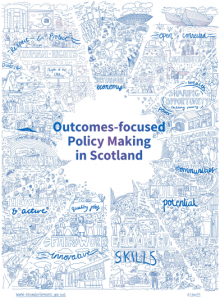National Performance Framework
How to solve a problem like policy for outcomes. Or ‘Outcomes-focused policy making in Scotland: A guide’
February 9, 2021 by Lesley Thomson No Comments | Category policy making, resource
Almost exactly a year ago, on 13 February 2020, we sat down in St Andrews House with some lovely folks from Bridge 47, the IDEAS network, SDG Network Scotland, Scotland’s International Development Alliance and Oxfam Scotland.
The lovely folks had a proposal. Did we want to work with them to develop guidance to help policy makers work with the National Performance Framework (NPF) and the Sustainable Development Goals (SDGs)?

Well, of course we did!
At that point, of course, we had no idea what the rest of 2020 would bring. And that our initial plans to work with policy colleagues to develop the guidance would need to be re-thought.
So, our wee policy making guide has taken a little bit longer to create than originally anticipated. And it wasn’t quite the co-design process we’d imagined. But, thanks to some amazing work by Bridge 47 colleagues, we now have something we’re very proud of.
Why is it important?
Policy is a mechanism for creating change. To achieve the National Outcomes, our policy making must be inclusive and take a holistic view of systemic problems.
What’s the guide for?
We weren’t looking to create a comprehensive guide to policy making. That would be a task of Herculean properties. And anyway, we already have guidance for much of the policy development process. Instead, the guide aims to fill what was a bit of a gap in the existing guidance – developing policy that supports the National Outcomes.
The guide will be useful at any stage of the policy process. But it’s particularly effective in the early stages of policy development, for example, when reviewing existing policy, defining the problem and setting outcomes.
What’s in the guide?
We’ve split the guide into two parts. The first part is a general overview of the SDGs and the NPF and how they’re interlinked.
The second part uses a Global Citizenship Education approach, with practical activities to apply the NPF and SDGs in the policy making process, in an inclusive and reflective way. It’s an approach that can help us step back from business as usual and develop a shared engagement with the SDGs and the NPF.
The guide also explains how a Policy Coherence for Sustainable Development (PCSD) approach can help ensure that policy making is joined up.
The SDGs, the NPF and PCSD are not new. However, their delivery and the systems thinking that underpin them is not straightforward and depend heavily on building shared commitment, enthusiasm and drive. Our guide aims to support that process.
And who’s the guide for?
We designed the guide with the Scottish Government’s policy profession in mind. The policy profession encompasses many roles in government, and makes up approximately 50% of the Scottish Government workforce.
Like the other professions in the civil service, the policy profession has a competency framework which sets out the skills needed to operate effectively. The Scottish Government has adapted the Civil Service Policy Profession Standards framework to reflect our distinctive Scottish Approach to policy making.
These standards are supported by a digital curriculum – combining formal learning and best practice guidance for each stage of policy development. The guide now forms part of that curriculum.
And, actually, most civil servants work in policy making organisations or organisations that mix policy with operational delivery. The guide is relevant to all of us in government.
Beyond government, the overall approach and the practical exercises featured in the guide can be helpful in many contexts.
What next?
We’ll continue to develop the guide – taking on feedback from policy colleagues who’ve used it. If you try out the guide, please let us know what you think of it!
We’re also developing additional resources to compliment the guide, including case studies and a community of practice.
Where can I find out more?
- Download the toolkit from the National Performance Framework website.
- Find out more about Bridge 47
- The guide also highlights the importance of transformative education and SDG Target 4.7. Find out more about SDG 4
- Scotland’s International Development Alliance has created an open and editable wiki resource for individuals and organisations interested in improving PCSD in Scotland.
Tags: Global Citizenship Education, PCSD, Policy Coherence for Sustainable Development, policy profession, SDG Target 4.7

Leave a comment